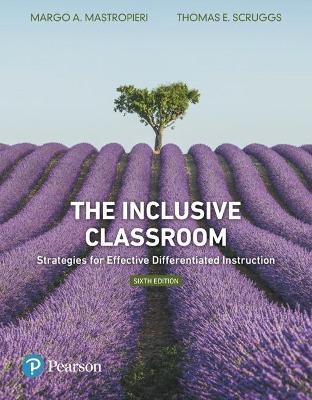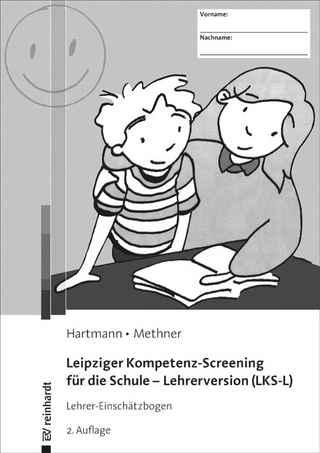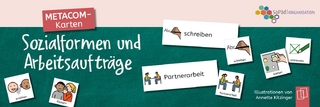
The Inclusive Classroom
Pearson
978-0-13-499571-7 (ISBN)
If purchasing or renting from companies other than Pearson, the access codes for the MyLab™ Education with Enhanced Pearson eText may not be included, may be incorrect, or may be previously redeemed. Check with the seller before completing your purchase.
For courses in Inclusion or Introduction to Special Education.
Research-based classroom and content strategies for the inclusive classroom.
The Inclusive Classroom: Strategies for Effective Differentiated Instruction, Sixth Edition captures the best of inclusion practices. Using a non-categorical approach, Mastropieri and Scruggs explain the fundamentals of inclusive teaching, the most effective general teaching practices, and ways to differentiate instruction for specific content areas. Targeted teaching strategies show ways to improve all students' memory, attention, motivation, study skills, and peer interaction. Research Highlights features validate strategies and demonstrate why particular techniques are best practice. Filled with classroom-ready tips and checklists, this revision includes an expanded chapter on Response to Intervention (RTI) and Multi-Tiered Systems of Support (MTSS), more coverage of the Common Core State Standards (CCSS) and Universal Design for Learning (UDL), and the latest strategies relating to academic success.
Personalize learning with MyLab Education
MyLab Education is an online homework, tutorial, and assessment program designed to work with the text to engage students and improve results. Within its structured environment, students see key concepts demonstrated through real classroom video footage, practice what they learn, test their understanding, and receive feedback to guide their learning and ensure they master key learning outcomes.
0134995716 / 9780134995717 The Inclusive Classroom: Strategies for Effective Differentiated Instruction, MyLab Education with Enhanced Pearson eText, and Loose-Leaf Version -- Access Card Package
Package consists of:
0134450434 / 9780134450438 The Inclusive Classroom: Strategies for Effective Differentiated Instruction -- MyLab Education Access Card
0134895029 / 9780134895024 The Inclusive Classroom: Strategies for Effective Differentiated Instruction
Margo Mastropieri, Ph.D., is University Professor Emerita, College of Education and Human Development, George Mason University. She has served as a Diagnostic-Remediator for the Learning Center at Mount Holyoke College, and as a classroom teacher for students with special needs, from preschool to secondary levels, in Massachusetts and Arizona. Prior to her present position, she served as University Professor of Special Education at George Mason University. Earlier she was a Professor of Special Education at Purdue University, and as Assistant Professor of Special Education at Utah State University, where she also worked as a researcher at the Early Intervention Research Institute. She earned her Ph.D. from Arizona State University. She has co-directed federally funded research projects in mnemonic strategy instruction, inclusive science and social studies education, and writing instruction at the elementary, middle school, and high school levels, in addition to directing undergraduate and doctoral level personnel preparation grants. From 1991 to 1997 she served as Co-Editor of Learning Disabilities Research & Practice, the journal of the Division for Learning Disabilities of the Council for Exceptional Children. From 1992 to 2011 she served as Co-Editor of the research annual Advances in Learning and Behavioral Disabilities (Emerald). From 2009 to 2015 she served as Co-Editor of Exceptional Children, the research journal for the Council for Exceptional Children. Among her publications are over 200 journal articles, 67 chapters in books, and 31 co-authored or co-edited books. In 2007, she was awarded the distinguished University Professor title from George Mason University. In 2008 she was the recipient of a Teaching Excellence Award at George Mason University, In 2010, she was the recipient of the Virginia Outstanding faculty Award, which is the Commonwealth’s highest honor for faculty at Virginia’s public and private colleges and universities. Tom Scruggs is University Professor Emeritus, George Mason University. He served as a classroom teacher for students with special needs, including gifted students, from preschool to secondary levels in Massachusetts and Arizona. Prior to his present position, he served as University Professor of Special Education at George Mason University. Earlier he was a Professor of Special Education at Purdue University, where he also had served as Director of the Purdue Achievement Center; and as a Research Assistant Professor at Utah State University. He earned his Ph.D. from Arizona State University. He has directed or co-directed externally funded research projects in peer tutoring, test-taking skills, mnemonic strategy instruction, and inclusive science and social studies education, at the elementary, middle school, and high school levels. From 1991 to 1997 he served as Co-Editor of Learning Disabilities Research & Practice, the journal of the Division for Learning Disabilities of the Council for Exceptional Children. From 1992 to 2011 he served as Co-Editor of the research annual Advances in Learning and Behavioral Disabilities (Emerald). Since 2009 to 2015 he served as Co-Editor of Exceptional Children. Among his publications (mostly in collaboration with Margo Mastropieri) are over 200 journal articles, 61 chapters in books, and 32 co-authored or co-edited books. In 2010, he received the Scholarly Achievement Award from the College of Education and Human Development at George Mason University. Both authors are the recipients of the 2006 “CEC Special Education Research Award,” as well as the 2011 “Distinguished Research Award” from the American Educational Research Association: Special Education Special Interest Group for their research efforts in working with and advocating on behalf of individuals with exceptionalities.
PART 1 THE FUNDAMENTALS
Introduction to Inclusive Teaching 3
Collaboration: Partnerships and Procedures 25
Teaching Students with Higher-Incidence Disabilities 53
Teaching Students with Autism and Lower-Incidence Disabilities 79
Teaching Students with Other Special Learning Needs 105
PART 2 DEVELOPING EFFECTIVE TEACHING SKILLS
Effective Differentiated Instruction for All Students 125
Response to Intervention and Multi-Tiered Systems of Support 153
Improving Motivation and Social Behavior 175
Promoting Inclusion with Classroom Peers 207
Improving Attention and Memory 229
Teaching Study Skills 255
Assessment 279
PART 3 TEACHING IN THE CONTENT AREAS
Literacy 307
Mathematics 343
Science, Social Studies, and Transitions 375
PART 1 THE FUNDAMENTALS
CHAPTER 1: Introduction to Inclusive Teaching 3
LEARNING OUTCOMES 3
What Are the Educational Rights for Individuals with Disabilities? 5 The Least Restrictive Environment 6
Where Are Students with Disabilities Served? 6 Mainstreaming and Inclusion, 6 Who Is
Served Under IDEA? 7 Other Instances of Classroom Diversity, 9
Legal Foundations 9
Legal Proceedings and Legislation, 9 Section 504, 10 Americans with Disabilities Act, 11
Individuals with Disabilities Education Act (IDEA), 12 No Child Left Behind Act (NCLB) of 2001 and Every Student Succeeds Act (ESSA) of 2015, 14
Models of Service Delivery 16
The Continuum of Services, 16 Where Are Most Students with Disabilities Served? 17
What Are General Education Classroom and Consultation Services? 17 What Are Resource and Self-Contained Services? 18 Special Schools and Special Facilities, 18 What Other Related Services Are Available? 19 Full Inclusion, 19 What Does This Debate Mean for Teachers? 20 Teacher Attitudes, 21
SUMMARY 23
CHAPTER 2: Collaboration: Partnerships and Procedures 25
LEARNING OUTCOMES 25
Collaboration to Meet Students’ Needs 27
Shared Goals, 27
Effective Communication 27
Strategies for Communicating Effectively, 27
Collaboration and Communication for Intervention 30
General Education Prereferral Request, 30 The Intervention Process, 32
Collaboration for Referrals and Placements 34 Collaboration as Partnerships 43
Consultation Between Special and General Educators, 43 Co-Teaching, 43
Strategies for Collaborating with Paraprofessionals, 45 Strategies for Collaborating Effectively with Parents and Families, 46
SUMMARY 49
INCLUSION CHECKLIST 50
CHAPTER 3: Teaching Students with Higher-Incidence Disabilities 53
LEARNING OUTCOMES 53
Speech or Language Impairments 54
Prevalence, Definitions, and Characteristics of Speech or Language Impairments, 54
Causes of Speech or Language Impairments, 54 Identification and Assessment of Speech or Language Impairments, 55 Strategies for Making Adaptations for Students with Speech or Language Impairments, 55
Learning Disabilities 57
Prevalence and Definitions of Learning Disabilities, 57 Causes of Learning Disabilities, 58
Issues in Identification and Assessment of Learning Disabilities, 58 Characteristics of Learning Disabilities, 59 Strategies for Making Classroom Adaptations for Students with Learning Disabilities, 60
Intellectual Disabilities 62
Prevalence and Definitions of Intellectual Disabilities, 62 Causes of Intellectual Disabilities, 64
Issues in Identification and Assessment of Intellectual Disabilities, 64 Characteristics of Intellectual Disabilities, 64 Strategies for Making Classroom Adaptations for Students with Intellectual Disabilities, 66
Emotional Disturbance 68
Prevalence and Definitions of Emotional Disturbance, 68 Causes of Emotional Disturbance, 68
Issues in Identification and Assessment of Emotional Disturbance, 68 Characteristics of Emotional Disturbance, 69 Strategies for Making Classroom Adaptations for Students with Emotional Disturbance, 69
Attention Deficit Hyperactivity Disorder (ADHD) 72
Definitions, Prevalence, and Characteristics of ADHD, 72 Causes of ADHD, 73 Issues in Identification and Assessment of ADHD, 73 Strategies for Making Classroom Adaptations for Students with Attention Deficit Hyperactivity Disorder, 74
SUMMARY 76
INCLUSION CHECKLIST 77
CHAPTER 4: Teaching Students with Autism and Lower-Incidence Disabilities 79
LEARNING OUTCOMES 79
Autism 79
Prevalence, Definitions, and Characteristics of Autism, 79 Strategies for Making Classroom Adaptations for Students with Autism, 80
Physical Disabilities and Other Health Impairments 83
Prevalence, Definitions, and Characteristics of Physical Disabilities and Other Health Impairments, 83 Physical and Health-Related Disabilities, 84 Strategies for Making Classroom Adaptations for Students with Physical Disabilities and Other Health Impairments, 88
Severe and Multiple Disabilities 92
Prevalence, Definitions, and Characteristics of Severe and Multiple Disabilities, 92 Strategies for Making Classroom Adaptations for Students with Severe and Multiple Disabilities, 93
Visual Impairments 97
Prevalence, Definitions, and Characteristics of Visual Impairments, 97 Strategies for Making Classroom Adaptations for Students with Visual Impairments, 98
Hearing Impairments Including Deafness 99
Prevalence, Definitions, and Characteristics of Hearing Impairments, 99 Educational Programming, 100 Strategies for Making Classroom Adaptations for Students with Hearing Impairments, 101
SUMMARY 102
INCLUSION CHECKLIST 103
CHAPTER 5: Teaching Students with Other Special Learning Needs 105
LEARNING OUTCOMES 105
Gifted, Creative, and Talented 105
Definitions, Prevalence, and Characteristics of Gifted, Creative, and Talented, 105
Issues in Identification and Assessment of Gifted, Creative, and Talented, 107 Strategies for Making Adaptations for Students Who Are Gifted, Creative, and Talented, 107
Students Who Are Culturally and Linguistically Diverse 108
Prevalence, Definitions, and Characteristics of Culturally and Linguistically Diverse
Students, 108 Issues in Identification and Assessment of Culturally and Linguistically Diverse Students, 112 Strategies for Making Adaptations for Students from Culturally and Linguistically Diverse Backgrounds, 113
Students at Risk 116
Definitions, Prevalence, and Characteristics of Students at Risk, 116 Coordinating Instruction with Compensatory Education Programs, 120 Strategies for Making Adaptations for Students at Risk, 120
SUMMARY 121
INCLUSION CHECKLIST 122
PART 2 : DEVELOPING EFFECTIVE TEACHING SKILLS
CHAPTER 6: Effective Differentiated Instruction for All Students 125
LEARNING OUTCOMES 125
What Is Differentiated Instruction? 125
Promoting Effective Differentiated Instruction: The PASS Variables 127
P: Prioritize Instruction 127
Strategies for Planning for Content Coverage, 127
A: Adapt Instructional Methods, Instructional Materials, or the Learning Environment 129
Strategies for Making Adaptations, 130
S: Systematically Teach with the SCREAM Variables 136
Strategies for Implementing the SCREAM Variables, 136 Strategies for Maximizing On-Task Behavior, 141 Strategies for Maximizing Time for Learning, 144
S: Systematically Evaluate the Outcomes of Your Instruction 146
Strategies for Promoting Systematic Evaluation of Instruction, 147
Putting the PASS Variables to Work: Including Model Lesson Components in Instruction 149
SUMMARY 150
INCLUSION CHECKLIST 151
CHAPTER 7: Response to Intervention and Multi-Tiered Systems of Support 153
LEARNING OUTCOMES 153
What Is RTI? 154
Schoolwide Screening, Progress Monitoring, and Data-Based Decision Making 155
Strategies for Administering Schoolwide Screening, 155 Strategies for Progress Monitoring and Data-Based Decision Making, 156
Tier 1: Effective Instruction in General Education 163
Features of Tier 1 Instruction, 163 Strategies for Implementation of Tier 1 Instruction, 164
Tier 2: Intervention to Remediate 164
Features of Tier 2 Instruction, 165 Strategies for Implementation of Tier 2 Instruction, 165
Considerations in Implementation of Tier 2 Instruction, 167
Tier 3: Individualized, Intensive Instruction 167
Strategies for Implementation of Tier 3 Instruction, 168
Fidelity of Implementation 168
Strategies for Determining Fidelity of Implementation, 169
Strategies for Implementing RTI at The Secondary Level, 170
Challenges with Implementing RTI 171
SUMMARY 172
INCLUSION CHECKLIST 173
CHAPTER 8: Improving Motivation and Social Behavior 175
LEARNING OUTCOMES 175
Setting the Stage for Academic Success 175
Strategies for Improving Motivation and Affect, 176
Improving Classroom Behavior and Social Skills 184
Managing Classroom Behavior, 184 Strategies for Observing and Recording Classroom Behavior, 184 Strategies for Using Effective Classroom Management Methods, 187
Strategies for Less-Intensive Classroom Management Methods, 187 Strategies for More Formal Classroom Management Methods, 189 Strategies for Handling Classroom Confrontations, 195 Strategies for Implementing Schoolwide Discipline Systems, 196
Strategies for Confronting Bullying, 198
Teaching Social Skills 200
Strategies for Social Skills Training, 201
SUMMARY 203
INCLUSION CHECKLIST 204
CHAPTER 9: Promoting Inclusion with Classroom Peers 207
LEARNING OUTCOMES 207
Peer-Supported Social Acceptance 207
Strategies for Promoting Social Acceptance, 207
Peer Assistance 208
Strategies for Enlisting Peer Assistance, 209
Peer Tutoring 211
Benefits of Peer Tutoring, 214 Strategies for Implementing a Tutoring Program, 215
Strategies for Promoting Learning with Classwide Peer Tutoring, 215
Cooperative Learning 219
Strategies for Implementing Cooperative Learning, 219 Advantages and Challenges of Cooperative Learning, 224
SUMMARY 226
INCLUSION CHECKLIST 227
CHAPTER 10: Improving Attention and Memory 229
LEARNING OUTCOMES 229
Attention 229
Attention and Students with Special Needs, 229 Strategies for Improving Attention, 230
Strategies for Addressing Extreme Cases of Attention Deficits, 234
Memory 236
Strategies for Improving Memory, 236 Strategies for Improving Memory with Mnemonic Techniques, 242
SUMMARY 252
INCLUSION CHECKLIST 253
CHAPTER 11: Teaching Study Skills 255
LEARNING OUTCOMES 255
Tools for Developing Independent Learners 256
Strategies for Developing Personal Organizational Skills, 256 Strategies for Promoting Listening Skills, 263 Strategies for Teaching Note- Taking Skills, 267
Research and Reference Skills 271
Strategies for Teaching Library Skills, 272 Strategies for Preparing Reports and Projects, 274
SUMMARY 276
INCLUSION CHECKLIST 277
CHAPTER 12: Assessment 279
LEARNING OUTCOMES 279
Types of Tests 279
Performance Assessments and Portfolio Assessments, 280
Adapting Tests for Students with Special Needs 282
Strategies for Administering Norm-Referenced Tests, 282 Strategies for Adapting Competency-Based Local and Statewide Assessment, 284 Strategies for Adapting Teacher-Made and Criterion-Referenced Tests, 286 Strategies for Using Curriculum-Based
Measurement, 289 Strategies for Using Performance Assessment, 290 Strategies for Using Portfolio Assessment, 291
Teach Test-Taking Skills 295
Strategies for Teaching Test-Taking Skills, 295
Grading 300
Strategies for Adapting Report Card Grading, 300
SUMMARY 302
INCLUSION CHECKLIST 303
PART 3: TEACHING IN THE CONTENT AREAS
CHAPTER 13: Literacy 307 LEARNING OUTCOMES 307 Approaches to Reading 308
Strategies for Implementing Approaches to Reading, 308 Common Core State Standards in Reading 311 Teaching Reading Skills 312
Strategies for Promoting Word Identification, 312 Strategies for Promoting Reading
Fluency, 316
Reading Comprehension 318
Strategies for Teaching Reading Comprehension, 318 Strategies for Implementing Multi-Tiered Reading Instruction with RTI, 326
Written Expression 327
Strategies for Improving Handwriting, 327 Strategies for Teaching Spelling, 329 Strategies for Teaching Written Communication, 332
SUMMARY 338
INCLUSION CHECKLIST 339
CHAPTER 14: Mathematics 343
LEARNING OUTCOMES 343
Mathematics Education 343
Mathematics and Students with Disabilities 344 Teaching Math in Inclusive Settings 345
Strategies for Teaching Beginning Math, 346 Strategies for Teaching Addition and
Subtraction, 347 Strategies for Teaching Multiplication and Division, 355 Strategies for Teaching Problem Solving, 361 Strategies for Teaching About Money and Time, 363
Strategies for Teaching Fractions and Decimals, 364 Strategies for Teaching Area and Volume Concepts, 366 Strategies for Teaching Algebra, 367 Strategies for Teaching Functional Math, 371
SUMMARY 372
INCLUSION CHECKLIST 373
CHAPTER 15: Science, Social Studies, and Transitions 375
LEARNING OUTCOMES 375
Adapting Textbook-Oriented Approaches in Science and Social Studies 376
Common Core State Standards Relevant to Science and Social Studies, 376 Strategies for Effective Teaching in Science and Social Studies, 377 Strategies for Promoting Independent Learning from Textbooks, 379 Strategies for Adapting Textbook Materials, 385
Adapting Activities-Oriented Approaches in Science and Social Studies 391
Strategies for Adapting Science Activities, 391 Strategies for Adapting Life Science Activities, 394 Strategies for Adapting Earth Science Activities, 395 Strategies for Adapting Physical Science Activities, 396 Strategies for Adapting Social Studies Activities, 397
Inquiry Learning in Science and Social Studies 400
Strategies for Adapting Inquiry Learning Activities, 400
Transitions 402
Planning for Transition, 402 Strategies for Promoting Transitions, 403 Strategies for Transitioning for the Future, 407
SUMMARY 409
INCLUSION CHECKLIST 410
REFERENCES 412
NAME INDEX 445
SUBJECT INDEX 450
| Erscheint lt. Verlag | 23.3.2018 |
|---|---|
| Sprache | englisch |
| Maße | 217 x 277 mm |
| Gewicht | 1114 g |
| Themenwelt | Sozialwissenschaften ► Pädagogik ► Sonder-, Heil- und Förderpädagogik |
| ISBN-10 | 0-13-499571-6 / 0134995716 |
| ISBN-13 | 978-0-13-499571-7 / 9780134995717 |
| Zustand | Neuware |
| Haben Sie eine Frage zum Produkt? |
aus dem Bereich


